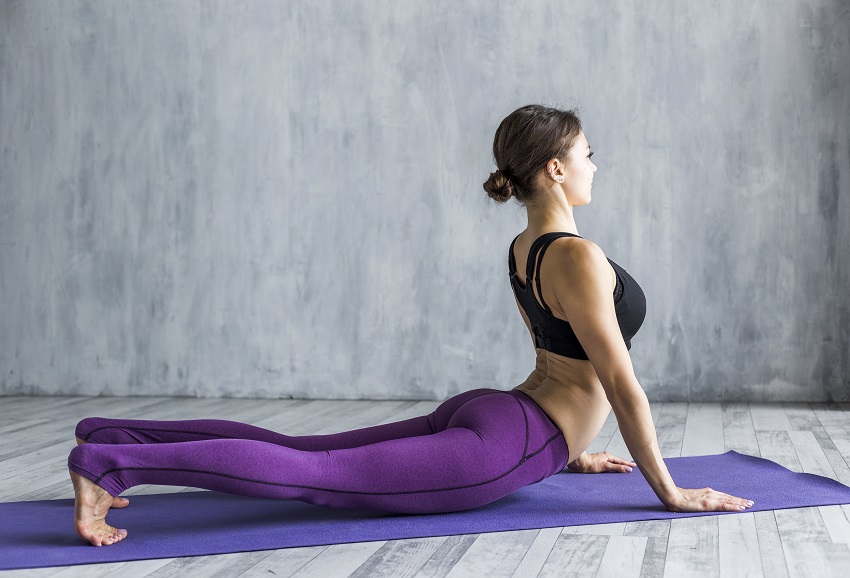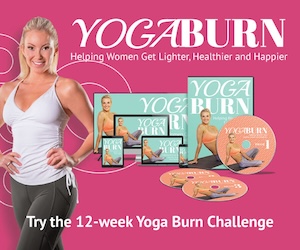Cobra Pose (Bhujaṅgāsana)
Name: Cobra Pose
Sanskrit: Bhujaṅgāsana
Pronunciation: Bhu-jang-aasana
Pose Level: Cobra Pose is among the few postures taught at all levels. For example, beginner, intermediate, and advanced styles of yoga classes.
Related Article: A Guide To Hot Yoga Class For Beginners: My First Hot Yoga Class!

Muscle Groups Involved in Cobra Pose
Cobra Pose engages various muscle groups throughout the body, offering a comprehensive workout. These include:
- Lower Body Flexors: Ankle, hip, and cervical flexors are activated, aiding in flexibility and movement.
- Core and Chest Muscles: It works on the abdominal and pectoral muscles, enhancing core strength and chest expansion.
- Arm Muscles: Biceps and brachialis are engaged, contributing to arm strength.
- Lower Back and Leg Muscles: The pose strengthens the hamstrings and glutes while engaging spinal extensors for back support.
- Upper Back Muscles: It effectively targets the upper back muscles, crucial for upper body strength and posture.
- Arm Extensors: Triceps are also involved, promoting overall arm toning and strength.
Benefits of Cobra Pose
Practicing Cobra Pose can offer a multitude of health benefits:
- Reduction in Back Pain: By strengthening the spinal extensors, it helps in alleviating lower back pain.
- Decreased Inflammation: Regular practice may lead to reduced inflammation in various parts of the body.
- Improved Sleep Quality: The relaxing and stretching nature of the pose can enhance sleep quality.
- Enhanced Posture: Strengthening the core and back muscles contributes to improved posture, reducing the risk of posture-related issues.
In summary, Cobra Pose is not just a stretching exercise; it’s a comprehensive posture that strengthens and tones various muscle groups while offering significant health benefits, including pain relief, improved sleep, and better posture.
Related Article: Yoga for Better Sleep: Learn Why Bedtime Yoga, Works!
Step-by-Step Instructions for Cobra Pose (Bhujangasana)
| Step | Instruction |
|---|---|
| 1 | Begin by lying flat on your stomach. Position your hands alongside your thighs, with your legs slightly apart and toes pointed backward. Ensure your palms face upward and rest your forehead on the floor. |
| 2 | Bend your arms at the elbows and place your hands on the floor beside your shoulders, aligning your thumbs under your armpits. |
| 3 | Gently elevate your head, neck, shoulders, and upper trunk by engaging your back muscles. Allow your spine to naturally arch as you draw your shoulders back. |
| 4 | Lift your gaze upward, maintaining a smooth, even breath. |
| 5 | Apply gentle pressure through your hands into the mat to deepen the stretch, being mindful not to overextend. |
| 6 | Slowly and with control, lower your body back to the starting position on the floor. |
This sequence for Cobra Pose is designed to ensure a safe and effective practice, focusing on gradual movements and proper alignment. It’s important to listen to your body and move within a comfortable range, especially when working with backbends.
Modifications for Cobra Pose (Bhujangasana)
Cobra Pose can be adapted to suit different levels of flexibility and strength. Here are some variations and modifications to consider:
Variations of Cobra Pose:
Half Cobra Pose (Ardha Bhujangasana or Sphinx Pose):
- Increases overall flexibility and is beneficial for alleviating back stiffness.
- Involves a milder backbend, making it suitable for beginners or those with limited back flexibility.
Cobra Pose with Raised Hand:
- Offers an excellent workout for the buttocks.
- Involves lifting one or both hands off the ground while in the Cobra Pose, increasing the intensity of the backbend.
Advanced Cobra Pose (Saral Hasta Bhujangasana):
- Elevates the head higher, resembling a cobra’s hood.
- Provides more support to the upper body using the arms, increasing the stretch in the back muscles.
Curve Hands Cobra Pose (Vakra Hasta Bhujangasana):
- Involves curving the hands, adding an additional element of balance and stretch to the traditional Cobra Pose.
Modifications for Ease and Support:
Use of Supportive Props:
- Place a folded blanket or towel under the hips or wrists for added comfort and support, especially if experiencing discomfort in these areas.
Forearm Support:
- Resting on the forearms instead of the palms can reduce strain, allowing for better control over the movement and maintaining a straighter spine.
Starting from Plank Pose:
- For a more intensive stretch, initiate the Cobra Pose from a Plank position, adding an element of strength training to the flow.
Related Article: Improve & Complete Your Yoga Routine: The Essential Yoga Props For All Skill Levels!
These variations and modifications allow practitioners to tailor the Cobra Pose to their individual needs, making it accessible and beneficial for a wide range of yogis. Whether you’re a beginner or more advanced, incorporating these adaptations can enhance your practice and help you experience the pose in new ways.
Contraindications for Cobra Pose (Bhujangasana)
While Cobra Pose offers many benefits, it’s crucial to be aware of certain conditions where this pose might not be suitable:
Post-Abdominal Surgery:
- Individuals recovering from recent abdominal surgery should refrain from practicing Cobra Pose. It’s important to wait until receiving clearance from a healthcare provider before resuming this asana.
Ulcers and Hernia:
- Those suffering from ulcers or hernia are advised to avoid this pose, as it may exacerbate these conditions.
Neck and Spinal Conditions:
- If you have neck issues, such as spondylitis, or other spine-related problems, it’s best to skip this pose. The strain placed on these areas during the pose could lead to discomfort or injury.
During Pregnancy:
- Pregnant women should generally avoid Cobra Pose, especially in later stages of pregnancy. The pose puts strain on the lower abdomen, which could be risky for both the mother and the baby.
In any yoga practice, listening to your body and respecting its limits is key. If you have any of these conditions, consult with a healthcare professional or a qualified yoga instructor to find suitable alternatives that can provide similar benefits without risk. Remember, yoga is about nurturing your body, not pushing it beyond its safe limits.
Poses Commonly Transitioned too:
Balasana or child pose (pushing upward and backward) or Adho Mukha Svanasana (downward-facing dog) are two frequent positions to transition into the following cobra pose.
Poses Commonly Transitioned From:
Before starting the cobra pose, you may perform the following as a warm-up:
Cat Cow pose with shoulders pressing away, and down the spine, Ustrasana and Kapotasana (deep back arches), and the last is one leg king pigeon pose, which provides an intense backstretch highly necessary for the cobra pose.




